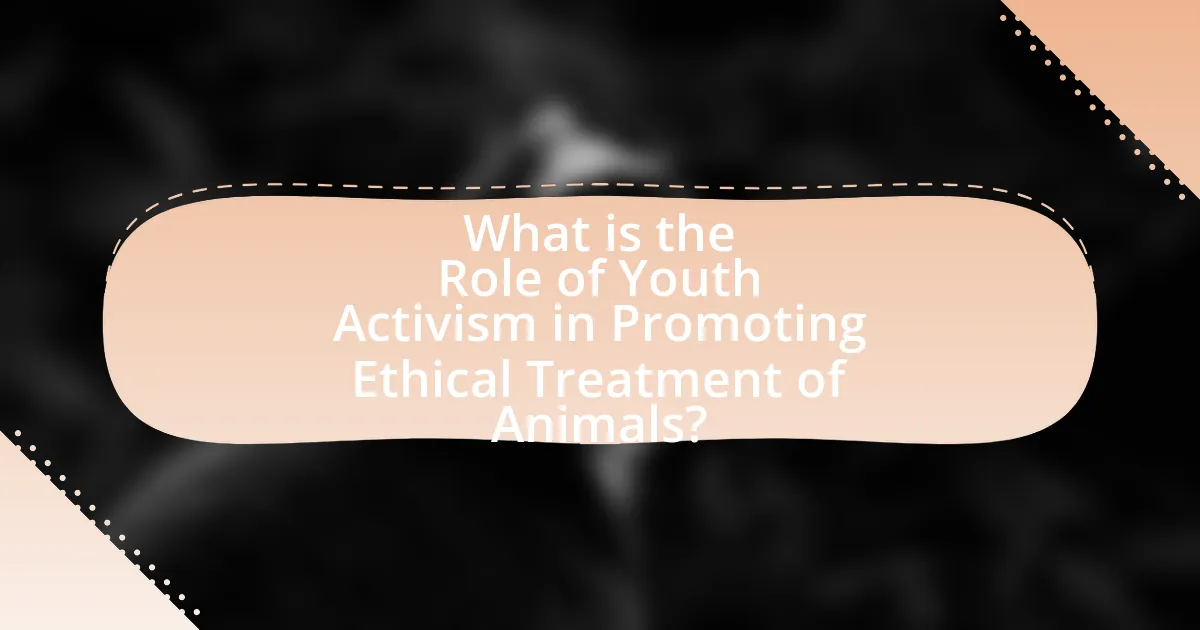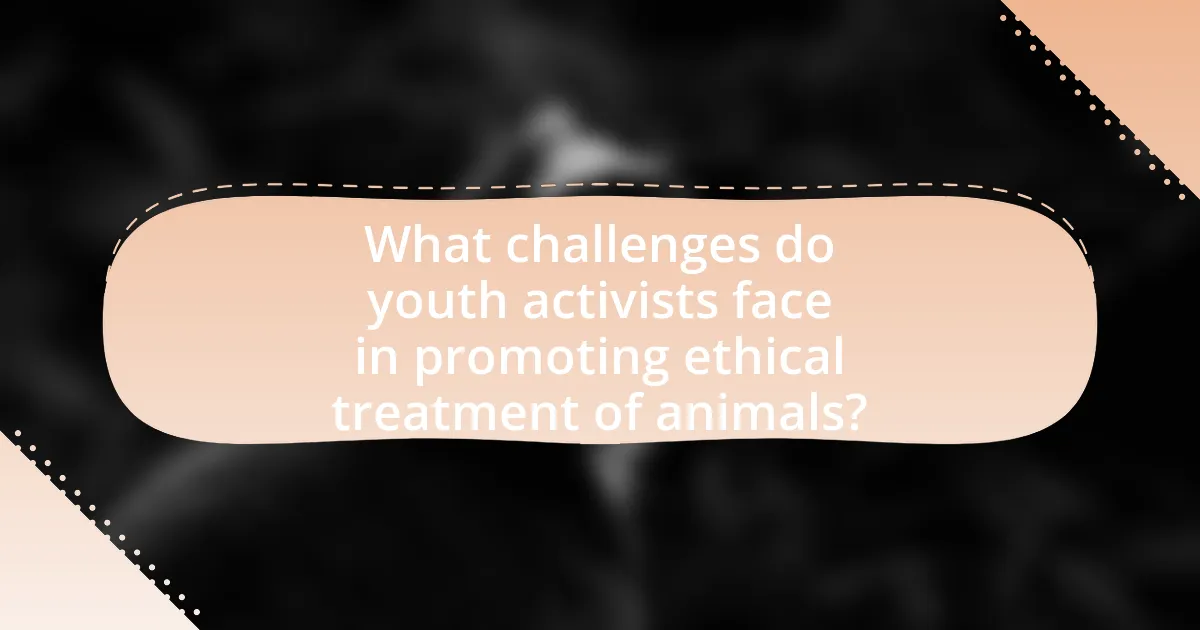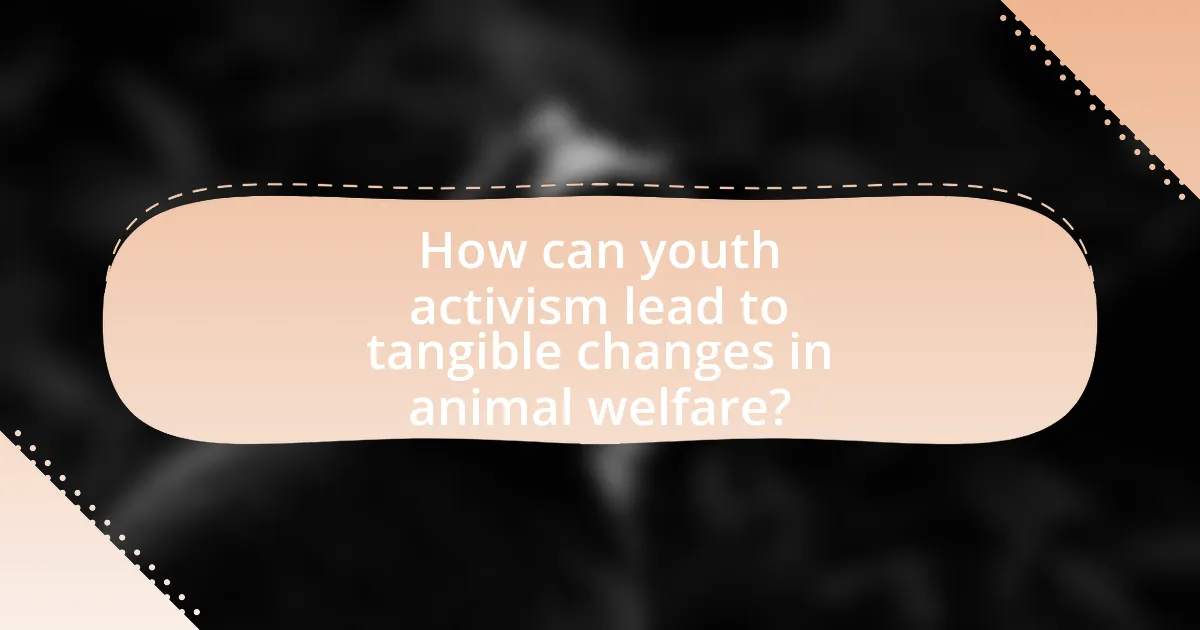Youth activism plays a pivotal role in advocating for the ethical treatment of animals by raising awareness, influencing public opinion, and driving legislative changes. Young activists leverage social media to mobilize support and disseminate information about animal rights issues, leading to successful campaigns that promote cruelty-free practices and foster a culture of compassion. The article explores the strategies employed by youth activists, the challenges they face, and the impact of their efforts on public perception and policy regarding animal welfare. It highlights the importance of education and community engagement in empowering young people to effect tangible changes in animal rights legislation and practices.

What is the Role of Youth Activism in Promoting Ethical Treatment of Animals?
Youth activism plays a crucial role in promoting the ethical treatment of animals by raising awareness, influencing public opinion, and driving legislative change. Young activists utilize social media platforms to disseminate information about animal rights issues, mobilizing their peers and communities to take action. For instance, campaigns led by youth organizations have successfully pressured companies to adopt cruelty-free practices, as seen in the rise of veganism among younger demographics, which has increased demand for humane alternatives. Additionally, youth-led initiatives often engage in direct action, such as protests and educational outreach, which have been shown to effectively challenge societal norms regarding animal exploitation. Research indicates that youth activism not only fosters a sense of responsibility towards animals but also cultivates leadership skills and civic engagement among young people, further amplifying their impact on ethical treatment practices.
How does youth activism influence public perception of animal rights?
Youth activism significantly influences public perception of animal rights by raising awareness and mobilizing support for ethical treatment. Young activists utilize social media platforms to disseminate information, share personal stories, and organize campaigns that highlight animal welfare issues. For instance, the rise of movements like “Fridays for Future” has shown how youth can effectively advocate for broader environmental and ethical concerns, including animal rights, leading to increased public discourse and engagement. Research indicates that youth-led campaigns often resonate with their peers and the general public, resulting in a shift in attitudes towards animal rights, as evidenced by a 2021 survey from the Humane Society which found that 70% of young respondents support stronger animal protection laws.
What strategies do young activists use to raise awareness about animal welfare?
Young activists employ various strategies to raise awareness about animal welfare, including social media campaigns, community outreach, and educational initiatives. Social media platforms like Instagram and TikTok allow them to share impactful visuals and stories that resonate with a broad audience, effectively increasing engagement and awareness. For instance, campaigns such as #AdoptDontShop have gained significant traction, encouraging pet adoption and highlighting the plight of shelter animals.
Additionally, young activists often organize local events, such as protests, workshops, and informational booths, to engage their communities directly. These events provide opportunities for face-to-face interaction, fostering discussions about animal rights and welfare. Educational initiatives in schools and community centers further amplify their message, teaching younger generations about ethical treatment and the importance of animal welfare.
Research indicates that youth-led movements can significantly influence public opinion and policy changes regarding animal welfare, as seen in the increased support for animal rights legislation in various regions. This combination of digital engagement and grassroots activism demonstrates the effectiveness of young activists in promoting awareness and driving change in animal welfare.
How effective are social media campaigns in promoting ethical treatment of animals?
Social media campaigns are highly effective in promoting the ethical treatment of animals, as they leverage vast networks to raise awareness and mobilize support. Research indicates that campaigns on platforms like Instagram and Twitter can reach millions, significantly increasing public engagement and advocacy for animal rights. For instance, a study by the University of Southern California found that social media activism led to a 30% increase in donations to animal welfare organizations during high-profile campaigns. This demonstrates that social media not only spreads information rapidly but also translates into tangible support for ethical treatment initiatives.
Why is youth activism crucial for the animal rights movement?
Youth activism is crucial for the animal rights movement because it brings fresh energy, innovative ideas, and a strong commitment to social justice. Young activists often leverage social media platforms to raise awareness and mobilize support, effectively reaching a broader audience. For instance, campaigns led by youth have successfully influenced public opinion and policy changes, such as the 2019 youth-led climate strikes that highlighted the connection between environmental issues and animal welfare. This generational engagement not only fosters a culture of compassion towards animals but also ensures that the movement remains relevant and dynamic in addressing contemporary ethical concerns.
What unique perspectives do young activists bring to the conversation on animal ethics?
Young activists bring fresh, innovative perspectives to the conversation on animal ethics by emphasizing intersectionality, sustainability, and the urgency of climate change. They often connect animal rights with broader social justice issues, advocating for a holistic approach that considers the impact of animal exploitation on marginalized communities. For instance, studies show that younger generations are more likely to support plant-based diets and ethical consumption, reflecting a growing awareness of environmental sustainability and its ties to animal welfare. This demographic also utilizes social media effectively to raise awareness and mobilize support, making their voices resonate in contemporary discussions on ethical treatment of animals.
How does youth involvement shape policy changes regarding animal welfare?
Youth involvement significantly shapes policy changes regarding animal welfare by mobilizing public opinion and influencing legislative agendas. Young activists often utilize social media platforms to raise awareness about animal rights issues, leading to increased public engagement and pressure on policymakers. For instance, campaigns led by youth organizations have successfully advocated for bans on animal testing and improved conditions for farm animals, resulting in legislative changes in various countries. Research indicates that youth-led movements, such as the global climate strikes, have also highlighted the interconnectedness of environmental and animal welfare issues, prompting policymakers to consider animal welfare in broader environmental policies. This demonstrates that the active participation of youth can effectively drive significant policy reforms in animal welfare.

What challenges do youth activists face in promoting ethical treatment of animals?
Youth activists face significant challenges in promoting ethical treatment of animals, primarily due to limited resources, societal resistance, and lack of access to decision-making platforms. Limited funding and organizational support hinder their ability to effectively mobilize campaigns and outreach efforts. Societal resistance often manifests in the form of entrenched cultural norms and industries that prioritize economic gain over animal welfare, making it difficult for youth activists to gain traction. Additionally, youth activists frequently encounter barriers in accessing political and legislative processes, which restricts their influence on policy changes related to animal rights. These challenges are compounded by the generational gap in activism, where older generations may not prioritize or understand the urgency of animal welfare issues as perceived by younger activists.
How do societal attitudes impact youth activism for animal rights?
Societal attitudes significantly influence youth activism for animal rights by shaping the values and beliefs that drive young individuals to engage in advocacy. When society exhibits a strong commitment to animal welfare, youth are more likely to feel empowered and motivated to participate in activism, as they perceive their efforts as aligned with broader social norms. For instance, a 2020 survey by the Humane Society International found that 70% of young people believe that animal rights are important, indicating a strong societal endorsement that encourages activism. Conversely, negative societal attitudes, such as indifference or opposition to animal rights, can discourage youth from taking action, leading to a decrease in participation and visibility of their efforts. Thus, the prevailing societal perspective directly impacts the level of enthusiasm and engagement among youth activists in the animal rights movement.
What obstacles do young activists encounter in their campaigns?
Young activists encounter several obstacles in their campaigns for ethical treatment of animals, including limited access to resources, lack of experience, and societal pushback. Limited funding and organizational support hinder their ability to effectively mobilize and promote their causes. Additionally, young activists often face challenges in gaining credibility and recognition, as their age may lead to underestimation of their capabilities. Societal pushback can manifest in the form of criticism from established groups or individuals resistant to change, which can discourage young activists and impede their efforts. These obstacles collectively impact the effectiveness and reach of their campaigns.
How can youth activists overcome resistance from established organizations?
Youth activists can overcome resistance from established organizations by building coalitions and leveraging social media to amplify their voices. By forming alliances with like-minded groups, youth activists can create a united front that demonstrates widespread support for their cause, making it harder for established organizations to ignore their demands. Additionally, social media platforms allow youth activists to reach a broader audience quickly, mobilizing public opinion and increasing pressure on established organizations to adapt to changing societal values regarding ethical treatment of animals. For instance, campaigns like the #MeToo movement have shown how grassroots efforts can influence larger organizations and lead to significant changes in policies and practices.
What role does education play in empowering youth activists?
Education plays a crucial role in empowering youth activists by equipping them with knowledge, critical thinking skills, and the ability to articulate their ideas effectively. Through education, young activists gain an understanding of social issues, including ethical treatment of animals, which enables them to advocate for change with informed perspectives. Studies show that educated youth are more likely to engage in activism; for instance, a report by the National Youth Rights Association indicates that youth with higher educational attainment are more involved in social movements. This knowledge fosters confidence and encourages collaboration, allowing youth to mobilize and influence public opinion and policy regarding animal rights.
How can schools integrate animal ethics into their curricula?
Schools can integrate animal ethics into their curricula by incorporating interdisciplinary lessons that cover philosophy, biology, and social studies focused on animal rights and welfare. For instance, educators can develop modules that explore ethical theories related to animals, such as utilitarianism and rights-based approaches, alongside scientific studies on animal behavior and welfare. Research indicates that programs like the “Animal Ethics Curriculum” have successfully increased student awareness and engagement in ethical discussions about animals, demonstrating the effectiveness of such integration. Additionally, schools can facilitate projects that encourage students to participate in local animal welfare initiatives, fostering a sense of responsibility and activism.
What resources are available for young activists to learn about animal rights?
Young activists can access various resources to learn about animal rights, including educational websites, books, documentaries, and organizations dedicated to animal welfare. Websites such as PETA’s Youth Activism page and the Humane Society’s resources provide comprehensive information on animal rights issues and activism strategies. Books like “Animal Liberation” by Peter Singer and “The Animal Rights Debate” by Gary Francione offer foundational knowledge and differing perspectives on the topic. Documentaries such as “Earthlings” and “Dominion” visually illustrate the impact of animal exploitation and the ethical arguments for animal rights. Additionally, organizations like the Animal Legal Defense Fund and the World Animal Protection offer workshops, webinars, and volunteer opportunities that equip young activists with practical skills and knowledge to advocate effectively for animal rights.

How can youth activism lead to tangible changes in animal welfare?
Youth activism can lead to tangible changes in animal welfare by mobilizing public opinion and influencing policy decisions. For instance, campaigns led by young activists have successfully raised awareness about animal cruelty, resulting in legislative changes such as the banning of certain animal testing practices in various countries. A notable example is the 2019 campaign by youth organizations that contributed to the European Union’s decision to phase out the use of animal testing for cosmetics, demonstrating the direct impact of youth-led initiatives on animal welfare legislation.
What successful examples exist of youth-led initiatives in animal rights?
Successful examples of youth-led initiatives in animal rights include the “Youth for Animal Rights” movement and the “Animal Rights Youth Coalition.” These initiatives have mobilized young activists to advocate for legislative changes, raise awareness about animal cruelty, and promote veganism. For instance, the “Youth for Animal Rights” movement organized campaigns that resulted in significant policy changes in several schools, leading to the implementation of plant-based meal options. Additionally, the “Animal Rights Youth Coalition” has successfully engaged thousands of young people in protests and educational events, contributing to a growing public discourse on animal welfare issues. These initiatives demonstrate the impactful role of youth in advancing animal rights through grassroots activism and community engagement.
How have youth campaigns influenced legislation on animal protection?
Youth campaigns have significantly influenced legislation on animal protection by mobilizing public support and raising awareness about animal rights issues. For instance, campaigns led by organizations such as the Youth Animal Rights Coalition have successfully lobbied for stricter laws against animal cruelty, resulting in legislative changes in various states. In 2019, California passed a law banning the sale of fur products, largely driven by youth-led initiatives that highlighted the ethical implications of fur farming. Additionally, youth activism has utilized social media platforms to amplify their messages, leading to increased public engagement and pressure on lawmakers to enact animal protection laws. This combination of grassroots mobilization and digital advocacy has proven effective in shaping legislative outcomes related to animal welfare.
What partnerships can enhance the effectiveness of youth activism?
Collaborations with established non-profit organizations, educational institutions, and local government agencies can significantly enhance the effectiveness of youth activism. Non-profit organizations, such as animal rights groups, provide resources, mentorship, and a platform for youth to amplify their voices. Educational institutions can facilitate awareness campaigns and provide research opportunities, fostering informed activism. Local government agencies can offer support through policy advocacy and community engagement initiatives, creating a more conducive environment for youth-led efforts. These partnerships leverage expertise, resources, and networks, ultimately leading to more impactful activism in promoting ethical treatment of animals.
What practical steps can young activists take to promote ethical treatment of animals?
Young activists can promote ethical treatment of animals by engaging in awareness campaigns that educate their peers and communities about animal rights and welfare. These campaigns can include organizing workshops, distributing informative materials, and utilizing social media platforms to reach a broader audience. Research indicates that social media can significantly amplify messages, with studies showing that campaigns can increase public awareness and support for animal rights issues by up to 60%. Additionally, young activists can participate in or organize local events such as protests, fundraisers, or volunteer opportunities at animal shelters, which not only raise funds but also foster community involvement and compassion towards animals. By collaborating with established animal rights organizations, young activists can gain resources and support, enhancing their impact on promoting ethical treatment of animals.
How can youth organize effective campaigns in their communities?
Youth can organize effective campaigns in their communities by identifying specific issues related to animal welfare, mobilizing peers, and utilizing social media for outreach. By focusing on local animal rights concerns, such as promoting adoption from shelters or advocating against cruelty, youth can create targeted messages that resonate with their community. Research shows that campaigns leveraging social media platforms can increase engagement and awareness; for instance, a study by the Pew Research Center indicates that 69% of adults use social media, making it a powerful tool for spreading information and rallying support. Additionally, collaborating with local organizations can provide resources and amplify their efforts, leading to more impactful campaigns.
What are the best practices for engaging peers in animal rights activism?
The best practices for engaging peers in animal rights activism include fostering open dialogue, utilizing social media effectively, and organizing collaborative events. Open dialogue encourages sharing diverse perspectives, which can enhance understanding and commitment to animal rights issues. Effective use of social media platforms, such as Instagram and Twitter, allows activists to reach a broader audience, share impactful stories, and mobilize support quickly. Organizing collaborative events, such as workshops or community outreach programs, provides hands-on experiences that can deepen engagement and inspire action among peers. These practices are supported by studies indicating that peer influence significantly impacts youth activism, demonstrating that collective efforts can lead to increased awareness and advocacy for animal rights.